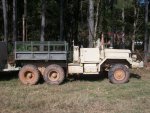Whoops
Whoops, stumps (respectfully, Chuck), not quite right on Archimedes (A). (Sorry to all, as this is an academic discussion and not related to our common interest in steel.) The "A Principle" (AP) applies only to liquids, and gasses. Mud is not a liquid. It is a "suspension." A suspension is composed of solid particles dispersed in a liquid. Thus, the density of the liquid supporting the suspension may be constantly changing, and there will be lack of uniformity in intermolecular forces of the supporting liquid. This will cause failure of the AP.
It might be useful to illustrate as follows: My wife asked me "What are you talking about, when you say that a melting ice berg will not raise ocean levels?" I replied "Why do you think that the volume of ice in the ice cube tray is greater than the volume of water from which it derived?" And, "Why do you think that the level of liquid in your drink that contains ice cubes does not change when the cubes melt?" One has to understand that while the AP is involved here, so is the concept of intermolecular forces. The reason that frozen water has greater volume than liquid water is the presence of hydrogen bonding in water. Hydrogen bonding is a weak bonding mechanism, but these bonds become very "organized" when water freezes, the affect being that the volume of the ice is greater than the liquid from which it came. This is why melting ice bergs don't raise ocean levels.
But the AP as it relates to ice bergs deals with only the submerged (less dense, due to increased intermolecular distances) ice. But it still works, just as the steel hull of a ship is buoyed up by the water it displaces, even though there is a great ship suprastructure, with it's mass, above the waterline. The weight of the entire ship is supported because of the decreased "density" of volume above water line, just as the weight of an iceberg (where most of the volume is above water line) is supported by the AP.
So density is clearly important. The liquid in mud is less dense because it is a suspension. Additional forces are thereby involved in mud, and the AP principle doesn't seem to apply to mud or other suspensions.
But not to worry. This corrects my thinking more than yours. In your case, it explains why the denser the mud the less you will sink, all other variables constant. In my case it explains why my Deuce will sink when driven into the ocean, while your weasel might not.
It's still possible I'm wrong. Many years since I've done computational chemistry and physics. Old now.
Oh! One more way deflating tires is helpful. Driving the Alaska (Alcan) Hwy, with its frost heaves. Just got back from Inuvik, Northwest Territories. AK Hwy to Whitehorse, Yukon, north to Dempster Hwy, north on Dempster (450 mi dirt, one way), to NWT and Beufort Sea. Farthest north you can go in Canada until it freezes. One way up Alcan I let 15 to 20 psi out and the
Deuce became much more comfortable. 8,000 miles.
Gary


